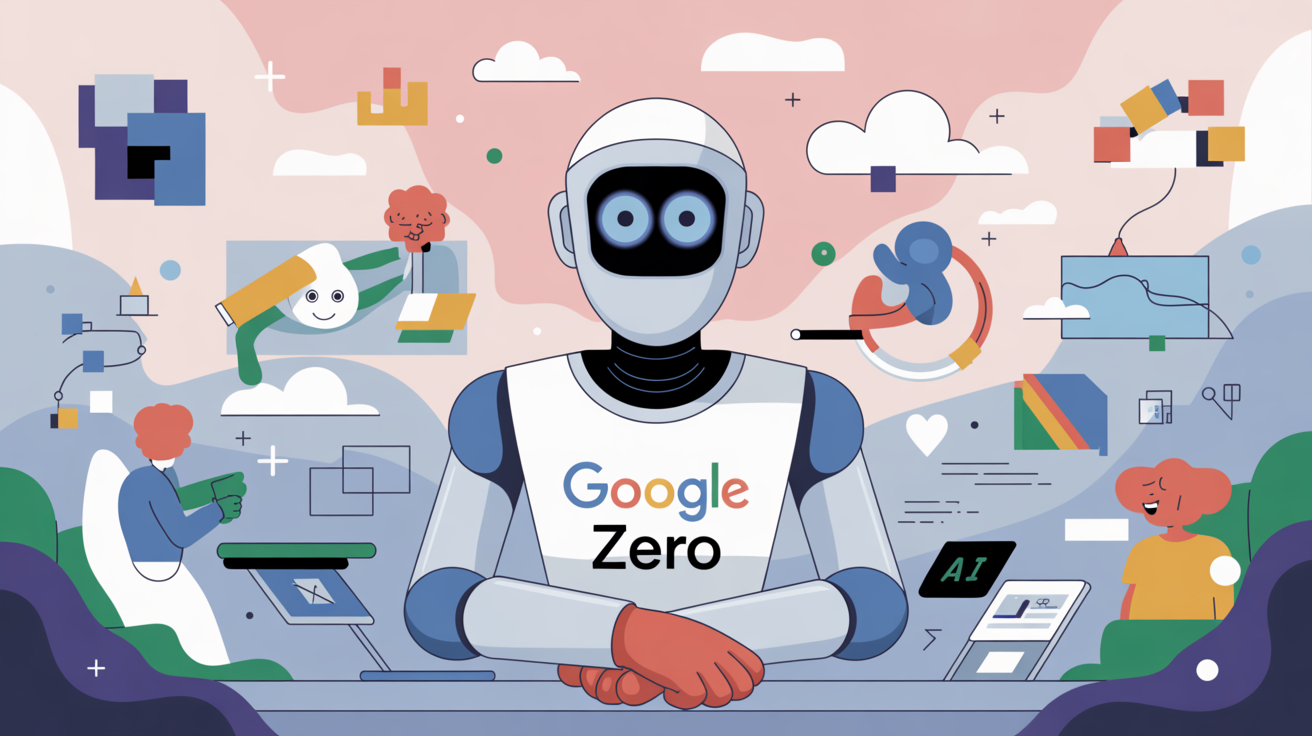
I. Understanding the ‘Google Zero’ Landscape
Definition: ‘Google Zero’ is the steady state where the majority of searches end without a click to a website, due to AI Overviews and other SERP features serving answers directly.
- 71% of searches end without an organic click—only 292 of every 1,000 searches produce a website visit (AdLift).
- News queries are hit hardest: zero-click rose from 56% (mid-2024) to 69% (May 2025) as AI answers became more prominent (Simplilearn).
- Mobile zero-click exceeds 75%, compounding the squeeze on CTR (ScrumDigital).
“Zero-click searches aren’t a trend; they’re the new norm. For every 1,000 searches on Google, only 292 result in an organic click.”
— Prashant Puri, AdLift (source)
Meanwhile, Google still dominates distribution—~80–89% search share in 2025—and organic search remains a major traffic source (WeAreTG). Translation: you can’t ignore Google, but you also can’t rely on it alone.
| Signal | Pre-AI Overviews (Typical) | Now (Google Zero) | Takeaway |
|---|---|---|---|
| Organic CTR (Top Spots) | 10–30% | <1% when AI Overviews dominate | Ranking ≠ traffic; optimise for answers and brand search. |
| Mobile Zero-Click | ~50–60% | >75% | Design for SERP visibility + owned channels. |
| News Zero-Click | 56% (mid-2024) | 69% (May 2025) | Speed + originality + owned distribution win. |
Key challenges we’ll solve here: how to capture demand beyond the SERP, the right traffic mix, and how to deploy AI to your advantage (rather than watching it siphon your clicks).
II. Strategic Traffic Mix Optimisation
A resilient growth model diversifies acquisition across owned, earned, and paid. Start by mapping exposure to Google risk, then rebalance with channels you control.
- Audit exposure: attribute revenue by channel, by intent (brand/non-brand), and by device. Flag “single-point-of-failure” dependencies.
- Rebalance: increase owned email and community reach; build partner referrals; deploy targeted paid to cushion seasonality.
- Stabilise: set guardrails (min % of pipeline from owned channels; min # of partner co-marketing slots per quarter).

Common pitfalls to avoid
- Ranking vanity: treating SERP position as success when CTR is suppressed.
- Attribution gaps: last-click bias undercounts content and community.
- ‘We’ll fix it later’ on email: deliverability debt compounds fast.
Measurement essentials
- North stars: qualified leads, pipeline velocity, revenue.
- Mix health: % of leads from owned channels; CAC payback; contribution margin by channel.
- Early warnings: impression-to-click deltas; branded search share; repeat visit rate.
| Channel | Resilience to Google | Time-to-Impact | Best Use |
|---|---|---|---|
| Email/Newsletter | High | Medium | Nurture, launches, content flywheel |
| LinkedIn (B2B) | Medium | Medium | Thought leadership, ABM engagement |
| Events/Webinars | High | Medium | Pipeline acceleration, community |
| Paid Search/Social | Medium | Fast | Fill gaps, test offers, retarget |
| SEO (Topic/Entity) | Medium | Slow | Authority, brand search growth |
Set your analytics to monitor mix shifts weekly. A simple rule: no single channel should deliver more than 40% of pipeline for two consecutive quarters.
III. Newsletter Strategy & Email Distribution Excellence
Your newsletter is the antidote to zero-click—a direct line to customers that isn’t throttled by someone else’s algorithm.
Choosing the right platform
- Klaviyo for ecommerce personalisation and robust flows.
- Mailchimp for simplicity and broad integrations.
- Beehiiv/Substack for audience growth and media-style publishing.
What to send (and why it works)
- Problem-solution briefs that echo common SERP questions.
- VP-level perspectives with a clear point of view (earns forwards and reposts).
- Launch notes + case wins to convert attention into pipeline.
How to measure success
- OPR (Open/Reached), CTR, CTO (click-to-open), Unique clicks to key actions, Revenue per send.
- Track list health: deliverability, spam rate <0.1%, bounce <2%.
Troubleshooting delivery
- Authenticate with SPF/DKIM/DMARC; warm new sending domains.
- Prune unengaged contacts quarterly; segment by recency.
- Balance image/text; avoid “spammy” formatting and link stuffing.
Result: compounding reach you actually own—and a predictable engine for launches and sales cycles.
IV. Social Distribution Mastery
Social is your second direct line. Treat it like a publication with a clear cadence and editorial spine.
Channel focus by outcome
- LinkedIn: B2B reach, ABM, partnership momentum.
- X (Twitter): timeliness, industry debate, analyst attention.
- Instagram: brand proof, behind-the-scenes, culture.
- YouTube: durable discovery, product education, talk tracks for sales.
Tooling to stay consistent
| Platform | Best for | Why it helps |
|---|---|---|
| Buffer | SMBs & lean teams | Simple scheduling, clean analytics |
| Hootsuite | Enterprises | Team workflows, monitoring at scale |
| Sprout Social | Insights-driven teams | Strong reporting, listening, CRM ties |
| Later | Visual brands | IG/TikTok planning, UGC workflows |
For reviews and comparisons, check a mix of vendor docs, G2, and hands-on trials—pick the tool that minimises friction for your publishing rhythm, not the one with the longest feature list.

V. AI-Powered Demand Capture Strategies
AI Overviews reduce clicks in Google. Use your own AI to increase conversions on your properties:
- On-site AI answers: conversational search over docs, pricing, specs, demos. Capture lead intent while users research.
- AI-assisted content: create structured explainers and calculators that address high-intent questions (and power your newsletter and social posts).
- Lead qualification: AI triage to route buyers to the right action (self-serve, demo, talk to sales).
Tools to build AI Overviews on your site
- Retrieval + LLM: vector DB (e.g., Pinecone/FAISS) + enterprise LLM (e.g., Claude, GPT-4o) with guardrails.
- Search middleware: Algolia/Elastic for fast retrieval, enriched with entity metadata.
- Governance: prompt libraries, citation requirements, and human-in-the-loop approvals.
What to measure
- Engagement: questions per session, helpfulness scores, doc opens.
- Conversion: assisted demo requests, calculator completions, time-to-first-value.
- Cost: cost/session, cost/qualified lead, ROI vs. traditional content.
Budgeting guideline: model cost per engaged session and compare to paid media CPL. In many B2B settings, well-governed AI experiences outperform generic gated PDFs for both UX and pipeline yield.
“SEO isn’t dead, but it’s undergoing the most significant transformation in its history. Brands must adapt to AI-driven search while maintaining core SEO principles.”
— WeAreTG (source)
“Many sites reported lower traffic while their search positions stayed the same… AI Overviews appear to be a major factor.”
— IMMWIT (source)
VI. Event-Driven Demand Generation
Events collapse the buying journey: content, community, and pipeline momentum in one motion. AI makes them lighter to run and easier to scale.
Plan with AI
- Use AI to cluster audience interests, draft agendas, and generate outreach sequences.
- Auto-build speaker briefs, promo snippets, and landing copy from a single source of truth.
Hybrid by default
- Livestream key segments; reuse recordings for YouTube and newsletter features.
- Provide post-event AI summaries and chaptered replays to extend reach.
Measure ROI
- Before: registrations by segment, partner reach, cost per registrant.
- During: attendance rate, engagement, Q&A depth.
- After: meetings booked, influenced pipeline, velocity.

VII. Integrated Demand Capture Framework
Bring it all together with tight feedback loops and clear attribution.
- Plan: define ICP signals and channel roles; set quarterly mix targets.
- Build: owned newsletter + on-site AI + social cadence + event calendar.
- Measure: multi-touch attribution, channel cost curves, assisted conversions.
- Improve: double-down on what compounds; retire what stalls.
Attribution tips: use a blended model (position-based + time decay) and track pathways not just last-click. Give credit to content and community that move people long before they convert.
VIII. Implementation Roadmap for B2B Success
Here’s a practical sequence SMEs and mid-market teams can ship within two quarters:
- Week 1–2: traffic risk audit, KPI reset, analytics QA.
- Week 3–4: newsletter relaunch (clean list, welcome flow, monthly cadence).
- Week 5–6: social editorial spine (weekly themes, pillar topics, posting rhythm).
- Week 7–10: on-site AI answers MVP (top 50 FAQs, docs ingestion, guardrails).
- Week 8–12: first flagship webinar or partner event; repurpose content.
- Ongoing: attribution refinement, CRO experiments, partner co-marketing.
Resource plan: a content lead, a marketing ops owner, and fractional AI/analytics support can run this. Add paid media to stabilise early targets while owned channels compound.
Stats & Sources at a Glance
| Insight | Stat | Source |
|---|---|---|
| Searches without a click | 71% | AdLift |
| News zero-click rate (May 2025) | 69% | Simplilearn |
| Mobile zero-click | >75% | ScrumDigital |
| CTR when AI Overviews dominate | <1% | Simplilearn |
| Google market share | 80–89% | WeAreTG |
FAQ: Fast Answers for Busy Teams
What is ‘Google Zero’ in plain terms?
It’s the reality that most searches never leave Google because answers appear inside the SERP via AI Overviews, snippets, and panels. Your strategy must therefore create demand you control—email lists, communities, and events—while still earning visibility in search.
Are AI Overviews killing SEO?
No, but they’ve changed the goalposts. You still need entity-led SEO for discovery and brand queries, but you also need owned channels to convert attention when clicks are scarce.
How do we measure newsletter success?
Look beyond opens. Track click-to-open, unique clicks to key actions, reply rate, meetings booked, and revenue per send. Monitor deliverability (spam rate <0.1%, bounce <2%) and list health.
Which social channels deliver the best B2B ROI?
LinkedIn is the workhorse for reach and ABM. YouTube compounds evergreen discovery. X helps with timeliness and analyst attention. Choose tools that keep your cadence effortless.
How do we evaluate an on-site AI Overview?
Measure questions per session, helpfulness votes, doc views, demo requests, and cost per engaged session. Compare ROI directly with paid media CPL and traditional gated content.


